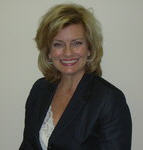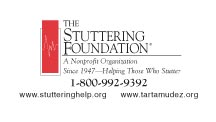Interview with Kristin Chmela, M.A., CCC-SLP, BRS-FD, Director of the Central Speech and Language Clinic's Chmela Fluency Center
Linda Schreiber:Thank you for agreeing to be interviewed about your work in the area of fluency, Kristin. You are the director of the Chmela Fluency Center, which is a center within the Central Speech and Language Clinic in Long Grove, Illinois. You also serve as adjunct faculty at Northwestern Univ
 Linda Schreiber:Thank you for agreeing to be interviewed about your work in the area of fluency, Kristin. You are the director of the Chmela Fluency Center, which is a center within the Central Speech and Language Clinic in Long Grove, Illinois. You also serve as adjunct faculty at Northwestern University and are a Board Recognized Specialist in Fluency. How did you develop an interest in fluency disorders?
Linda Schreiber:Thank you for agreeing to be interviewed about your work in the area of fluency, Kristin. You are the director of the Chmela Fluency Center, which is a center within the Central Speech and Language Clinic in Long Grove, Illinois. You also serve as adjunct faculty at Northwestern University and are a Board Recognized Specialist in Fluency. How did you develop an interest in fluency disorders? Kristin Chmela:I dealt with stuttering as I grew up. I became interested in the profession of speech pathology when I was a sophomore in college. I was a dance major my freshman year and because of an ankle injury, I had to quit; and that's when I met Dr. Hugo and Carolyn Gregory. They were my speech therapists. And for a college English class, I once gave a speech about stuttering and then realized I wanted to go into the field.
When I received my degree, I had no intention of specializing in stuttering. My first job in the public school setting gave me the opportunity to provide some staff development in the area of stuttering. I began seeking more information, consulting with other clinicians doing stuttering therapy, and then training clinicians in the area of stuttering. I went on to become part of the initial cadre of Board Recognized Specialists in Fluency and Fluency Disorders recognized by ASHA and have spent my career of 20 some years working with children who stutter.
Linda:The Chmela Fluency Center is known for treating individuals with fluency disorders but the majority of your clients are school-age children?
Kristin:: We specialize in the treatment of children of all ages. We have expertise in the areas of early intervention, school-age stuttering, and adolescent stuttering therapy.
Linda:Aside from your clinical time, you have written several products to help speech-language pathologists work with individuals who have fluency disorders. One such product is Focus on Fluency.


Kristin::Yes. Focus on Fluency is a product that consists of practical materials clinicians may refer to and use for executing stuttering intervention for school-aged children. It was based on approximately 20 years of working with school-age children who stutter.
Linda:And what treatment model is it aligned with?
Kristin::Focus on Fluency, while not a program, is based on materials appropriate for clinicians treating school-age children who stutter using an integrated approach to therapy, that is, an approach that helps children speak more fluently and/or stutter more easily in order to become the most effective communicators they can be. It provides materials to talk with children about normal talking and stuttering and includes activities that help desensitize negative attitudes and feelings regarding stuttering.
Linda:Focus on Fluency consists of five sections.
Kristin::Yes: education, desensitization, basic communication skills, fluency shaping, and stuttering modification. Within each section, there are a variety of practical materials.
For instance, the desensitization section has several stories of situations that happened to actual children who stutter; situations such as being teased or facing the challenges of getting into a conversation on the playground. After each story, there are several problem-solving questions.
Linda:Focus on Fluency also includes materials that address stuttering more directly?
Kristin::Yes, the third sectionbasic communication skillsprovides the clinician with materials to work on skills such as eye contact, wait time or thinking time, pausing, and turn-taking. The materials would be helpful when addressing these areas with children who have issues other than stuttering. The unique features of the materials from this section, as well as in the section for fluency shaping and stuttering modification, are the visual prompts or symbols on game cards that represent the skills being targeted.
As clinicians create opportunities to help children learn ways to speak more easily, they may also use a strategy included in the kit called "self/partner charting." This strategy focuses on increasing the child's ability to self-monitor and develop increased awareness of creating changes in the way he or she is communicating
Another strategy, "contract cards," provides a way for the clinician toe carryover phase of a therapy program. This includes creating small contracts for practicing specific skills in the classroom/other environments.
Linda:Focus on Fluency provides the materials for different aspects of stuttering intervention and clinicians can pick and choose those activities that work with the model they are using?
Kristin::Yes. And research in the area of school-age stuttering therapy is greatly needed. There are very few studies that provide evidence for protocols that are successful with this age group. While evidence supports fluency shaping approaches, research also shows the presence of negative attitudes and feelings associated with dealing with stuttering in some school-age children.
Kristin::I want to stress that Focus on Fluency is not a program, but rather a toolbox of materials that can make stuttering therapy easier for a clinician. Children who stutter are all different and we have to evaluate them, understand the needs they have, and develop goals for them individually.
Linda:Fluency Flips has just recently been released..

Kristin::Yes. Fluency Flips is a practical material that helps clinicians teach fluency shaping skills. This material supports teaching fluency shaping procedures as suggested by Dr. Hugo Gregory*. The approach includes using an easier, relaxed approach-smooth movements to help children initiate speech with an easier onset of phonation and lighter articulatory contacts, while moving smoothly through the rest of the phrase.
Linda: Fluency Flips separates the fluency shaping skills into different areas.
Kristin:: Yes. The skills focus on easy vowel onsets, where children learn to bring their vocal chords together in a gentle way; light consonant contact, where children learn to move their articulators gently; continuous sound, where children learn how to keep their voicing continuous through the rest of the phrase; and pausing, where children learn to stop in the middle of a sentence and then start again in the same manner. These skills are presented in a hierarchical manner and the layout of Fluency Flips provides a great way for children to "warm-up" for a therapy session with "quick drills."
Linda:So the flipbook will help teach children strategies for smooth speech. What's great is that you have online audio samples of each of the targeted skills so clinicians can have the opportunity to learn from your model. Fluency Flips and the audio samples can be found at www.superduperinc.com
Kristin::Yes, and another feature of Fluency Flips that is very exciting is that once you introduce easy vowel onsets and light consonant contacts, children can heighten their awareness of tense and relaxed onsets of sounds by practicing Tools Ropes. Tool Ropes include three contrasted productions, such as sound pops, regular sounds, and easier onsets or lighter contacts, of a sound or word.
And, Fluency Flips has beautiful pictures and includes visual prompts. There's also a page that has only words, phrases, and sentences with no pictures and no visual prompts and these pages will be useful for older students.
Linda: Kristin, you were also senior author of a bookThe School-Age Child Who Stutters: Working Effectively with Attitudes and Emotions**published by the Stuttering Foundation of America. This book focuses on working with children's attitudes and feelings about stuttering.

Kristin:Yes, that was published in 2001. It helps clinicians understand aspects such as how to talk with children about stuttering and how to assess their attitudes and feelings. It provides informal measures to talk with children about stuttering and to better understand their feelings about their stuttering. These measures may be helpful not only as part of the assessment process but also during treatment.
Linda:And products from the Stuttering Foundation of America are very inexpensive and can be found at www.StutteringHelp.org

Kristin:And of course, the Stuttering Foundation of America publishes many materials that educate teachers and parents about stuttering, and that help speech-language pathologists become better clinicians.
Linda: Kristin, you have given much to our profession. Clinicians are appreciative of what you create because these products help make a difference in the lives of our clients. Keep writing and presenting. Thanks for spending time with us today.
*Gregory, H.H. (2003). Stuttering therapy: Rationale and procedures (pp. 217-262). Boston: Allyn & Bacon.
**Chmela, K., & Reardon, N. (2001). Dealing with school-age children who stutter: Working effectively with attitudes and emotions. Memphis, TN: Stuttering Foundation of America.
